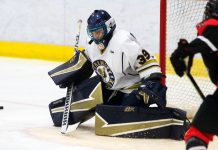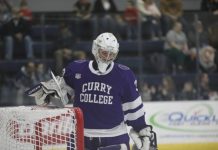Once again, hockey violence has stolen the spotlight. With the NHL regular season in its final weeks and the college game in playoff mode, we find ourselves pulled into the debate over what took place on a sheet of ice in Vancouver.
With good reason.
When the Canucks’ Todd Bertuzzi jumped Colorado’s Steve Moore, he was exacting revenge for the Avalanche player’s hit on Vancouver’s Markus Naslund weeks before.
Never mind that one game had already been played by between the two clubs with no one taking such a run at Moore. Never mind that Naslund had already returned from his concussion (he missed three games). Never mind that Moore was involved in a first period fight that most observers assumed would be the end of Vancouver’s thirst for justice.
None of that was enough, however, and as the game slipped out of reach for the Canucks — they were losing 5-1 at the time — Bertuzzi took it upon himself to drive home a message. The rest is history but, thankfully, not as tragic as it could have been.
“It may be a bit unfair to ask me because he’s [Steve Moore] an ECAC product,” said Colgate interim head coach Stan Moore earlier this week when asked for a reaction.
“I had the chance to recruit [Mark] Moore,” the Raiders’ coach said about the oldest of the three brothers to play at Harvard, “and thought that we were really close to getting him here at Colgate, but Harvard swooped in. I had the chance to get to know Steven. So, I feel close to the situation.”
The Raiders’ coach then grew more upset.
“There is no excuse for what Bertuzzi did. He made the choice and it really rankles me.”
Recent comments by Steve Moore’s mother, Anna, to the Associated Press sum up the general feeling of most observers. “I hope most of the hockey world is outraged,” she said this week. “When you see someone who loves the game as much as he does, this type of nonsense doesn’t have to come with it. That’s just a black mark for hockey, when human beings behave like that in front of the public eye and where little boys worship them.”
On Thursday, Bertuzzi was suspended for the rest of the regular season and the playoffs. His suspension will remain open-ended until Moore’s condition can be evaluated at next season’s training camp — if the league hasn’t locked out its players by that time.
“The punishment should befit the infraction,” said Colgate’s Moore. “I don’t think it is enough. It’s close, but I’m not really sure what would be enough.
“It’s important that he not be persecuted as just one person because then it almost trivializes everything. He can’t serve the punishment for the whole league. The game lets people do this.”
The Canucks, meanwhile, were fined $250,000 for not doing enough to control the situation before it got out of hand. Unfortunately, Vancouver head coach Marc Crawford was not punished. Not only did he refuse to tone down the public “revenge” talk leading up to the game, but he stood behind the bench with a smirk on his face as Moore was being carried off on a stretcher and Colorado coach Tony Granato was being restrained from going after his colleague.
“Crawford was a part of the whole thing,” said the Colgate coach. “He was part of the whole ‘We’re going to get him,’ and he opened the floodgates of players to do whatever they want.”
Which is exactly what St. Lawrence coach Joe Marsh, outspoken on the growing dangers in the sport, is quite concerned about.
“Bertuzzi is not the lone villain in this,” said Marsh. “He’s a big, tough guy, but this was something that was precipitated by a situation with Moore and Naslund. I worry about things like this that fester. I’m sure he didn’t want to break Moore’s neck, but you can’t say for sure. It’s like the Wild West and ‘retribution’ is out of control.
“I worry about this filtering down to other levels. It’s almost like there is a lack of respect for the physics of the sport and the alarming rise in concussions is the result.”
Ironically, Marsh thinks that the better equipment in today’s game is part of the reason for many of the serious injuries we see in the sport.
“We cover kids from head to toe,” he explained, “and they now have a sense of invulnerability. The full shields have brought the sticks up and the kids don’t know how to protect themselves.”
Stan Moore agrees.
“The facemask has allowed this,” he explained. “The shields have saved stitches and dental trips, but it has allowed things to migrate north.”
“The players are bigger, stronger and faster,” Marsh said, “and there’s a recklessness to the game. These are not just isolated incidents. It has evolved to this point and that’s pretty scary.
“It used to be about checking; now hockey is all about hitting. I’d like to think the game will address it and that it will get better. It’s preposterous.”
According to the longtime SLU coach, so is the concept of physical intimidation.
“It is such a huge factor, but why? You can be intimidating without that stuff. The symptoms in hockey have to be addressed and it needs to start at the top and filter down.”
Some would argue that the on-ice officials are missing opportunities to rein players in.
“Referees can only do so much,” explained Marsh. “It needs to start at the grassroots level at clinics and camps.”
Then Marsh unleashed his most telling and personal comment of the conversation.
“I’m just glad I don’t have any boys who are playing. It’s pretty frightening.
“I’m afraid for our guys and the other guys all the time. We have to get kids to control their emotion and within the context of playing the game properly. You never want less emotion, but you want to put it to work for you not against you. Just don’t let it cross the line.
“We’re not in the business of winning at all costs. At least I’m not. We have to respect the game. Nobody wants this on their conscience.”


